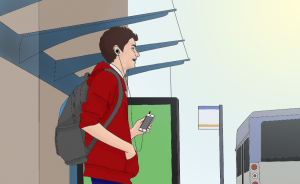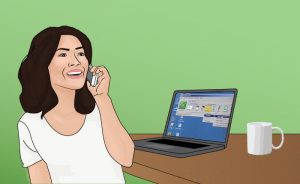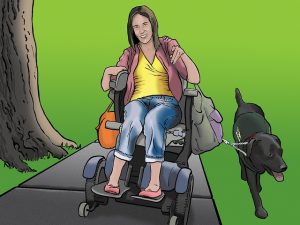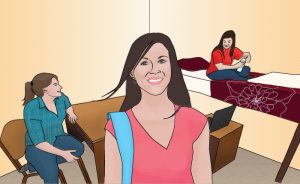2 Using Personas
Designers use personas to represent the different types of people who might access a website or product. In this toolkit, we have used personas to help you keep in mind the types of students and their various abilities while you’re developing content. We’ve also used these personas to introduce different types of hardware and software that students typically use.
We’ve adapted personas from Sarah Horton and Whitney Quesenbery’s book A Web for Everyone: Designing Accessible User Experience so they are specific to post-secondary students with print disabilities in British Columbia (based on data from CAPER-BC Annual Report [PDF] and the students who attended our focus group).
These are some of the students who will be reading the open textbooks that you write.
Mark
 Mark is 17 years old. He is a future heavy-duty mechanic with a learning disability that was diagnosed in Grade 8. Mark absorbs information best by hearing it and enjoys making and fixing stuff with his hands. He’s in his first semester of college, taking trades courses and loving it. Mark can’t wait to complete the foundation courses and move into his first apprenticeship placement. He lives at home with his family; they all share one computer.
Mark is 17 years old. He is a future heavy-duty mechanic with a learning disability that was diagnosed in Grade 8. Mark absorbs information best by hearing it and enjoys making and fixing stuff with his hands. He’s in his first semester of college, taking trades courses and loving it. Mark can’t wait to complete the foundation courses and move into his first apprenticeship placement. He lives at home with his family; they all share one computer.
Ability: Difficulty absorbing a lot of information when reading
Aptitude: Basic technology user
Attitude: Prefers to do things himself, but can get easily frustrated or impatient, especially with technology
Assistive technology: MP3 player
Format preference: MP3 so he can listen on the go
Listen to an MP3 recording of a synthetic voice.
Jacob

Jacob is a fourth-year business administration student who is blind and a bit of a geek. Jacob is 28 years old and can’t wait to get his last few classes out of the way so he can start his career. He shares an apartment with his girlfriend.
Ability: Blind since birth
Aptitude: Skilled technology user
Attitude: Digital native, early adopter, persists until he gets it
Assistive technologies:
- Screen reader (JAWS on his laptop, VoiceOver on his iPhone)
- Victor Reader Stream
- Audio recorder (to take notes)
- Refreshable Braille display
Format preference: Electronic text, which he can easily use in JAWS and with VoiceOver; detests PDFs
Watch a student using JAWS (4:08-6:18s).
Listen to a computer-science student’s screen reader.
Diana

Diana is retraining to be a personal coach after she experienced vision loss and was unable to continue working as a bus driver. She is 48 years old and taking many of her classes online. She lives with her husband.
Ability: Gradual loss of vision; can easily read using a magnifier, but her eyes fatigue quickly
Aptitude: Intermediate technology user
Attitude: Has a routine and likes to stick to it
Assistive technologies:
- ZoomText
- TextAloud text to speech software
Format preference: PDF or electronic text that she can enlarge on her computer or listen to using TextAloud
Watch a student using ZoomText (0-1:31).
Trish

Trish is a college student taking university transfer courses who prefers using print books. An accident left Trish with several physical disabilities. She is 18 years old and lives with her family.
Ability: Suffers from brain damage, paralysis, and has motor issues
Aptitude: Basic computer user, intermediate iPad user
Attitude: Generally dependent on family, so enjoys reading and studying independently
Assistive technologies:
- iPad
- Motorized wheelchair
Format preference: eBook formats, such as PDF, that can be easily loaded onto her iPad
Ann

Ann is a chemistry major with ADHD, a learning disability that makes it difficult for her to concentrate. She is 20 years old and hopes to become a pharmacist. Ann lives in a dorm on campus with two other female students.
Ability: ADHD, has difficulty concentrating
Aptitude: Intermediate computer user
Attitude: Struggles at times, but is very appreciative of how much learning software helps her
Assistive technology: Kurzweil learning software (on laptop)
Format preference: Reading and listening at the same time
Watch a student using Kurzweil on a computer (1:32-4:07).
Steven

Steven is an English major who is deaf. He is 23 years old and likes the flexibility of taking online classes. He lives by himself.
Ability: Native language is ASL; can speak and read lips
Aptitude: Intermediate technology user
Attitude: Can get annoyed about accessibility, such as lack of captions
Assistive technologies:
- CART (communication access real-time translation) for lectures
- Captions
- Video chat
Format preference: No preference in regards to textbook formats; but, videos without captions are meaningless
Watch a video demonstration of CART. Note: this video is also captioned.
Media Attributions
- Jacob: “WFE003: Jacob” by Rosenfeld Media. © Creative Commons Attribution 2.0 Generic Licence.
- Trish: “WFE002: Emily” by Rosenfeld Media. © Creative Commons Attribution 2.0 Generic Licence.
- Steven: “WFE005: Steven” by Rosenfeld Media. © Creative Commons Attribution 2.0 Generic Licence.
- Mark, Diana, Ann: Original artwork by Hilda Anggraeni (BCcampus). © Creative Commons Attribution 4.0 International Licence.

